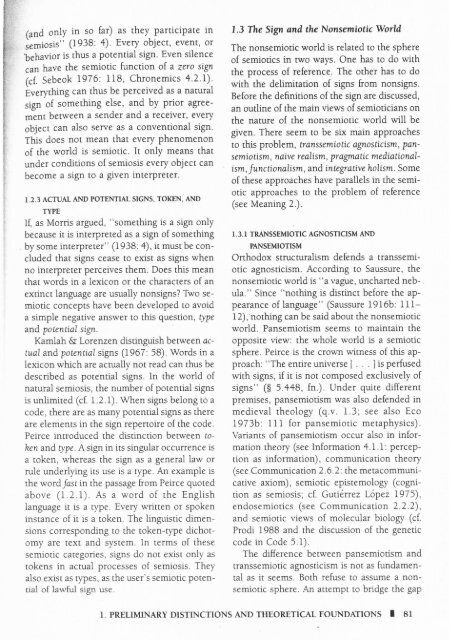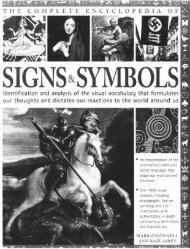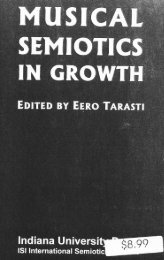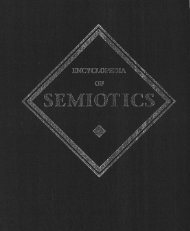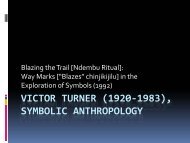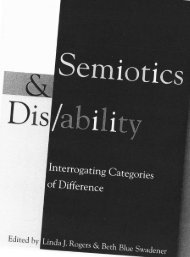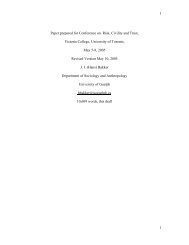Handbook of Semiotics by Winfried Noth - SemioticSigns.com
Handbook of Semiotics by Winfried Noth - SemioticSigns.com
Handbook of Semiotics by Winfried Noth - SemioticSigns.com
You also want an ePaper? Increase the reach of your titles
YUMPU automatically turns print PDFs into web optimized ePapers that Google loves.
W|<br />
E:r:.'<br />
g:ti::'<br />
i;,:,<br />
g.L<br />
F.<br />
Fr,.<br />
l'-<br />
L<br />
fl<br />
i,<br />
f'<br />
lr<br />
i<br />
I<br />
I<br />
i<br />
171nd only in so far) as they participate in<br />
semiosis" (I938: 4). Every object, event, or<br />
'behavior is thus a potendal sign. Even silence<br />
can have the semiotic function <strong>of</strong> a zero sign<br />
(cf. Sebeok L976: Ll8, Chronemics 4.2.i).<br />
Everything can thus be perceived as a natural<br />
sign <strong>of</strong> something else, and <strong>by</strong> prior agreement<br />
between a sender and a receiver, every<br />
obiect can also serve as a conventional sign.<br />
This does not mean that every phenomenon<br />
<strong>of</strong> the world is semiotic. It only means that<br />
under conditions <strong>of</strong> semiosis every object can<br />
be<strong>com</strong>e a sign to a given interpreter.<br />
I.2.3 ACTUAL AND POTENTIAL SIGNS, TOKEN, AND<br />
TYPE<br />
I[, as Morris argued, "something is a sign only<br />
because it is interyreted as a sign <strong>of</strong> something<br />
<strong>by</strong> some interpreter" (1938: 4), it must be concluded<br />
that signs cease to exist as signs when<br />
no interpreter perceives them. Does this mean<br />
that words in a lexicon or the characters <strong>of</strong> an<br />
extinct language are usually nonsigns? Two semiotic<br />
concepts have been developed to avoid<br />
a simple negative answer to this question, type<br />
and potential sign.<br />
Kamlah & Lorenzen distinguish between actual<br />
and potential signs (1967: 58). Words in a<br />
Iexicon which are acually not read can thus be<br />
described as potential signs. In the world <strong>of</strong><br />
natural semiosis, the number <strong>of</strong> potential signs<br />
is unlimited (cf. 1.2.I). When signs belong to a<br />
code, there are as many potential signs as there<br />
are elements in the sign repertoire <strong>of</strong> the code.<br />
Peirce introduced the distinction between tohen<br />
and type. Asign in its singular occurrence is<br />
a token, whereas the sign as a general law or<br />
rule underlying its use is a t1pe. An example is<br />
the word/ast in the passage from Peirce quoted<br />
above (1.2.I) As a word <strong>of</strong> the English<br />
language it is a type. Every written or spoken<br />
instance <strong>of</strong> it is a token. The linguistic dimensions<br />
corresponding to the token-type dichotomy<br />
are text and system. In terms <strong>of</strong> these<br />
semiotic categories, signs do not exist only as<br />
tokens in actual processes <strong>of</strong> semiosis. They<br />
also exist as types, as the user's semiotic potential<br />
<strong>of</strong> lawful sign use.<br />
1.3 The Sign and the Nonsemiotic World<br />
The nonsemiotic world is related to the sphere<br />
<strong>of</strong> semiotics in two ways. One has to do with<br />
the process <strong>of</strong> reference. The other has to do<br />
wirh the delimitation <strong>of</strong> signs from nonsigns.<br />
Before the definitions <strong>of</strong> the sign are discussed,<br />
an oudine <strong>of</strong> the main views <strong>of</strong> semiodcians on<br />
the nature <strong>of</strong> the nonsemiotic world will be<br />
given. There seem to be six main approaches<br />
to this problem, transsemiotic agnosticism, pansemiotism,<br />
naive realism, pragmatic mediationalism,<br />
functio nalism, and inte gr ativ e ho lism. Some<br />
<strong>of</strong> these approaches have parallels in the semiotic<br />
approaches to the problem <strong>of</strong> reference<br />
(see Meaning 2.).<br />
I.3 TMNSSEMIOTIC AGNOSTICISM AND<br />
PANSEMIOTISM<br />
Orthodox structuralism defends a transsemiotic<br />
agnosticism- According to Saussure, the<br />
nonsemiotic world is "a vague, uncharted nebula."<br />
Since "nothing is distinct before the appearance<br />
<strong>of</strong>language" (Saussure I9I6b: III-<br />
I2), nothing can be said about the nonsemiotic<br />
world. Pansemiotism seems to maintain the<br />
opposite view: the whole world is a semiotic<br />
sphere. Peirce is the crown witness <strong>of</strong> this approach:<br />
"The entireuniverse [ . . . ] isperfused<br />
wirh signs, if it is not <strong>com</strong>posed exclusively <strong>of</strong><br />
signs" ($ 5.448, fn.). Under quite different<br />
premises, pansemiotism was also defended in<br />
medieval theology (q.v. I.3, see also Eco<br />
I973b. III for pansemiotic meraphysics).<br />
Variants <strong>of</strong> pansemiotism occur also in information<br />
theory (see Information 4.1.I: perception<br />
as information), <strong>com</strong>munication theory<br />
(see Communication 2.6.2: the meta<strong>com</strong>municative<br />
axiom), semiotic epistemology (cognition<br />
as semiosis; cf. Guti6rrez Lopez 1975),<br />
endosemiotics (see Communicarion 2.2.2).<br />
and semiotic views <strong>of</strong> molecular biology (cf.<br />
Prodi 1988 and the discussion <strong>of</strong> the genetic<br />
code in Code 5.1).<br />
The difference between pansemiotism and<br />
transsemiotic agnosticism is not as fundamental<br />
as it seems. Both refuse to assume a nonsemiotic<br />
sphere. An attempt to bridge the gap<br />
I. PRELIMINARY DISTINCTIONS AND THEORETICAL FOUNDAIIONS I 8T


